
  

























 |
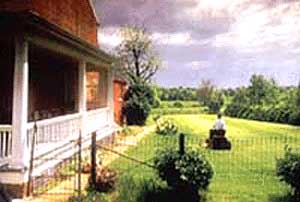
Historic building in significant designed landscape. |
The
landscape surrounding a historic building and contained within an
individual parcel of land is considered the building site. The
site, including its associated features, contributes to the overall
character of the historic property. As a result, the relationship
between the buildings and landscape features within the site's boundaries
should be considered in the overall planning for rehabilitation
project work.
Landscapes
which contain historic buildings are found in rural, suburban, and
urban communities and reflect environmental influences such as climate
as well as the historic period in which they were created. Landscapes
created for functional purposes as well as aesthetic enjoyment have
been a part of American history since European settlement. Historic
American styles in landscape design developed from 17th-18th century
Spanish and Colonial gardens, evolving into the pastoral and picturesque
design of the 19th century. Victorian carpet bedding, popular during
the late 19th century, produced profuse plantings of annuals and
perennials. Later, the early 20th century yielded a return to classical
traditions, with revival gardens reflecting European renaissance
design.
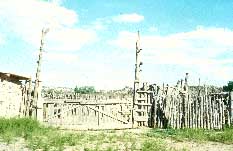 Rugged corral fence that connects two outbuildings.
Rugged corral fence that connects two outbuildings. |
The
building site may be significant in its own right, or derive its
significance simply from its association with the historic structure.
The level of significance, association, integrity, and condition
of the building site may influence the degree to which the existing
landscape features should be retained during the rehabilitation
project. In an industrial property, the site may be defined simply
as the relationship between buildings or between the ground plane
and open space and its associated buildings. Designed historic landscapes
significant in the field of landscape architecture require a more
detailed analysis of their character-defining features which may
include lawns, hedges, walks, drives, fences, walls, terraces, water
features, topography (grading) and furnishings. Vegetation is an
important feature in landscapes; this material, including both native
species and cultivated plants creates an appearance that is constantly
changing, both seasonally and annually. Since most plant material
is adapted to specific environments, the character of landscapes
varies dramatically in different climates, elevations and regions.
|
|
Building
Site
|
....Identify,
retain, and preserve
|
 |
|
recommended.....
|

|
| |
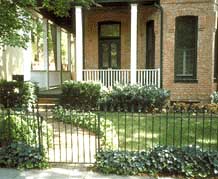
Distinctive
historic urban residential site. |
Identifying,
retaining, and preserving buildings and their features as well as
features of the site that are important in defining its overall
historic character. Site features may include circulation systems
such as walks, paths, roads, or parking; vegetation such as trees,
shrubs, fields, or herbaceous plant material; landforms such as
terracing, berms or grading; and furnishings such as lights, fences,
or benches; decorative elements such as sculpture, statuary or monuments;
water features including fountains, streams, pools, or lakes; and
subsurface archeological features which are important in defining
the history of the site.
Retaining
the historic relationship between buildings and the landscape.
|
|
not
recommended.....
|

|
| |
Removing
or radically changing buildings and their features or site features
which are important in defining the overall historic character of
the property so that, as a result, the character is diminished.
Removing
or relocating buildings or landscape features thus destroying the
historic relationship between buildings and the landscape.
Removing
or relocating historic buildings on a site or in a complex of related
historic structures--such as a mill complex or farm--thus diminishing
the historic character of the site or complex.
Moving
buildings onto the site, thus creating a false historical appearance.
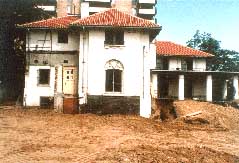
Important site features destroyed during rehabilitation. |
Radically
changing the grade on the property, or adjacent to a building. For
example, changing the grade adjacent to a building to permit development
of a formerly below-grade area that would drastically change the
historic relationship of the building to its site.
|
|
Building
Site
|
....Protect
and Maintain
|
 |
|
recommended.....
|

|
| |
Protecting and maintaining the building and building site by providing
proper drainage to assure that water does not erode foundation walls;
drain toward the building; nor damage or erode the landscape.
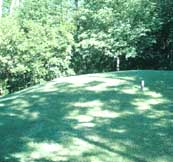 Ensuring archeological resource protection.
Ensuring archeological resource protection. |
Minimizing
disturbance of terrain around buildings or elsewhere on the site,
thus reducing the possibility of destroying or damaging important
landscape features or archeological resources.
Surveying
and documenting areas where the terrain will be altered to determine
the potential impact to important landscape features or archeological
resources. Protecting,
e.g., preserving in place important archeological resources.
Planning
and carrying out any necessary investigation using professional
archeologists and modern archeological methods when preservation
in place is not feasible.
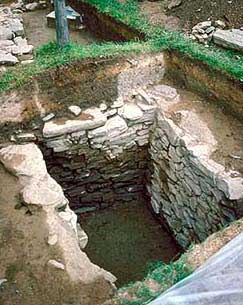
Archeological investigation using appropriate methodology. |
Preserving
important landscape features, including ongoing maintenance of historic
plant material.
Protecting
the building and landscape features against arson and vandalism
before rehabilitation work begin, i.e., erecting protective fencing
and installing alarm systems that are keyed into local protection
agencies.
Providing
continued protection of masonry, wood, and architectural metals
which comprise the building and site features through appropriate
cleaning, rust removal, limited paint removal, and re-application
of protective coating systems.
Evaluating
the overall condition of the materials and features of the property
to determine whether more than protection and maintenance are required,
that is, if repairs to building and site features will be necessary.
|
|
not
recommended.....
|

|
| |
Failing
to maintain adequate site drainage so that buildings and site features
are damaged or destroyed; or alternatively, changing the site grading
so that water no longer drains properly.
Introducing
heavy machinery into areas where they may disturb or damage important
landscape features or archeological resources.
Failing
to survey the building site prior to the beginning of rehabilitation
work which results in damage to, or destruction of, important landscape
features or archeological resources. Leaving
known archeological material unprotected so that it is damaged during
rehabilitation work.
Permitting
unqualified personnel to perform data recovery on archeological
resources so that improper methodology results in the loss of important
archeological material.
Allowing
important landscape features to be lost or damaged due to a lack
of maintenance.
Permitting
the property to remain unprotected so that the building and landscape
features or archeological resources are damaged or destroyed.
Removing
or destroying features from the buildings or site such as wood siding,
iron fencing, masonry balustrades, or plant material.
Failing
to provide adequate protection of materials on cyclical basis so
that deterioration of building and site feature results.
Failing
to undertake adequate measures to assure the protection of building
and site features.
|
|
Building
Site
|
....Repair
|
 |
|
recommended.....
|

|
| |
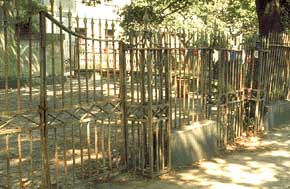
Historic iron fence to undergo repairs and re-finishing as part of rehabilitation work. |
Repairing
features of the building and site by reinforcing historic materials.
|
|
not
recommended.....
|

|
| |
Replacing
an entire feature of the building or site such as a fence, walkway,
or driveway when repair of materials and limited compatible replacement
of deteriorated or missing parts are appropriate.
Using
a substitute material for the replacement part that does not convey
the visual appearance of the surviving parts of the building or
site feature or that is physically or chemically incompatible.
|
|
Building
Site
|
....Replace
|
 |
|
recommended.....
|

|
| |
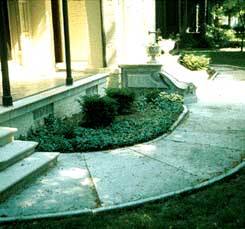
Deteriorated limestone walkway to be replaced in kind. |
Replacing
in kind an entire feature of the building or site that is too deteriorated
to repair if the overall form and detailing are still evident. Physical
evidence from the deteriorated feature should be used as a model
to guide the new work. This could include an entrance or porch,
walkway, or fountain. If using the same kind of material is not
technically or economically feasible, then a compatible substitute
material may be considered.
Replacing
deteriorated or damaged landscape features in kind.
|
|
not
recommended.....
|

|
| |
Removing a feature of the building or site that unrepairable and
not replacing it; or
replacing it with a new feature that does not convey the same visual
appearance.
Adding
conjectural landscape features to the site such as period reproduction
lamps, fences, fountains, or vegetation that is historically inappropriate,
thus creating a false sense of historic development.
|
| |
Design
for Missing Historic Features
The
following work is highlighted to indicate that it represents the
particularly complex technical or design aspects of rehabilitation
projects and should only be considered after the preservation concerns
listed above have been addressed.
|
|
recommended.....
|

|
| |
Designing
and constructing a new feature of a building or site when the historic
feature is completely missing, such as an outbuilding, terrace, or
driveway. It may be based on historical, pictorial, and physical
documentation; or be a new design that is compatible with the historic
character of the building and site.
|
|
not
recommended.....
|

|
| |
Creating
a false historical appearance because the replaced feature is based
on insufficient historical, pictorial, and physical documentation.
Introducing
a new building or site feature that is out of scale or of an otherwise
inappropriate design.
Introducing
a new landscape feature, including plant material, that is visually
incompatible with the site, or that alters or destroys the historic
site patterns or vistas.
|
| |
Alterations/Additions
for the New Use
The
following work is highlighted to indicate that it represents the
particularly complex technical or design aspects of rehabilitation
projects and should only be considered after the preservation concerns
listed above have been addressed.
|
|
recommended.....
|

|
| |
Designing new onsite parking, loading docks, or ramps when required by the
new use so that they are as unobtrusive as possible and assure the
preservation of historic relationship between the building or buildings
and the landscape.
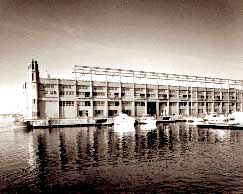
Appropriate
alteration of abandoned pier shed for new residential use that
illustrates visual harmony with waterfront site. .............................................................
|
Designing
new exterior additions to historic buildings or adjacent new construction
which is compatible with the historic character of the site and
which preserves the historic relationship between the building or
buildings and the landscape.
Removing
non-significant buildings, additions, or site features which detract
from the historic character of the site.
|
|
not
recommended.....
|

|
| |
Locating
any new construction on the building site where important landscape
features will be damaged or destroyed, for example, removing a lawn
and walkway and installing a parking lot.
Placing
parking facilities directly adjacent to historic buildings where
automobiles may cause damage to the buildings or to important landscape
features.
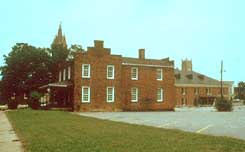
Site
inappropriately altered by large parking lot.
|
Introducing
new construction onto the building site which is visually incompatible
in terms of size, scale, design, materials, color, and texture;
which destroys historic relationships on the site; or which damages
or destroys important landscape features.
Removing
a building in a complex of buildings; or removing a building feature,
or a landscape feature which is important in defining the historic
character of the site.
|
|

